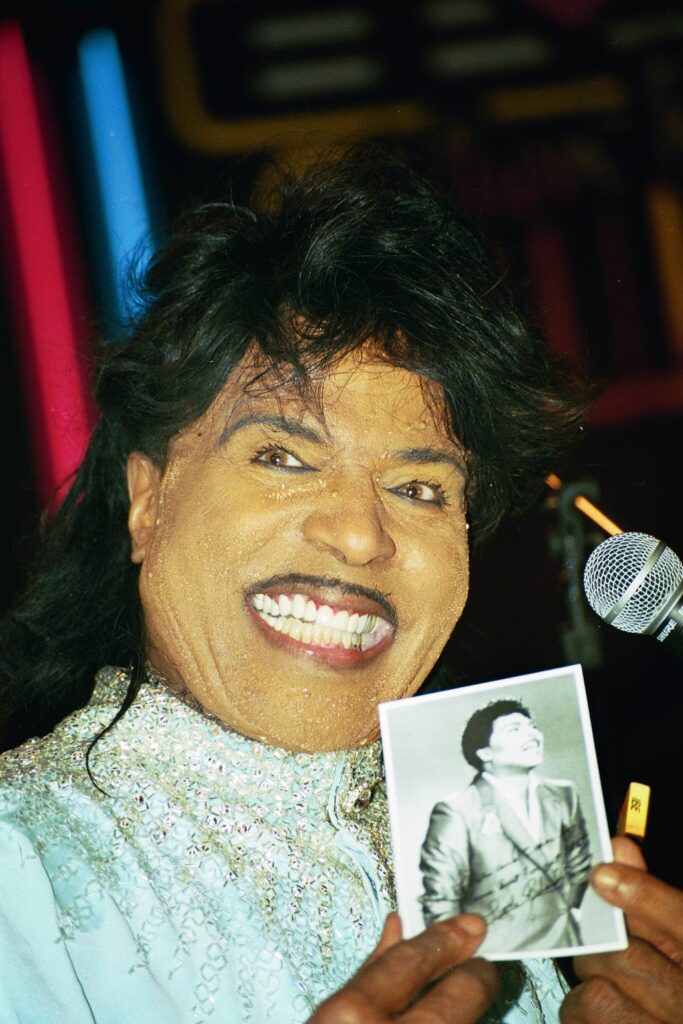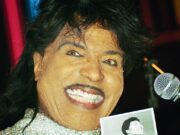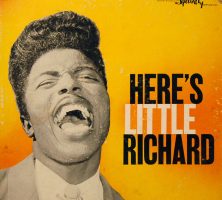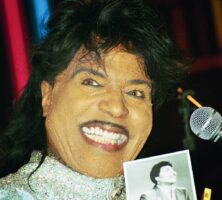Little Richard, also known as “the Georgia Peach,” was credited as the “architect of rock and roll”—a title he claimed for himself, but few disputed. In the mid-1950s, his wildly energetic rhythm-and-blues records crossed over to the pop charts and made him one of the first rock stars. His pounding piano, screaming vocals, and exuberant stage persona have been emulated but rarely matched by several generations of rock musicians.
Born Richard Wayne Penniman in Macon on December 5, 1932, Little Richard was one of twelve children. His father, Bud, worked as a brickmason, sold moonshine, and operated a juke joint called the Tip In Inn. Despite the business interests of Penniman’s father, the family was deeply involved in the church. Penniman’s mother, Leva Mae, met his father at a church revival, and Penniman’s grandfather and uncle were preachers. Penniman first performed in a family gospel group that often competed against other quartets in local contests. A part-time job at the Macon City Auditorium gave him the opportunity to study many leading rhythm-and-blues and gospel acts.

Penniman was a manic, unruly youngster whose flamboyant mannerisms and gay friends often put him in conflict with his father. He was fascinated by the traveling medicine shows that came through town, and at fourteen he left home with one. By the age of fifteen he had adopted the stage name Little Richard and was performing with Sugarfoot Sam From Alabam, a minstrel show that had toured the South for decades.
Little Richard soon gravitated to Atlanta, a focal point for the national rhythm-and-blues scene. At the 81 Theater, Little Richard met and was influenced by the singer Billy Wright, whose big hair, heavy stage makeup, and gospel-styled blues shouting made him a local favorite. Through WGST disc jockey Zenas Sears, Wright helped Little Richard secure a record contract with RCA, and at age eighteen he had his first recording session. While the results were undistinguished, the song “Every Hour” sold well in Atlanta and Macon. Another RCA session was a commercial failure.
Little Richard’s music career came to a halt after his father was murdered. To support his family, he took a job washing dishes at a Greyhound bus station in Macon. Eventually, he was back on stage, dominating the Macon rhythm-and-blues scene with a new band, the Upsetters. Bumps Blackwell at Specialty Records in Los Angeles, California, heard a demo tape of the band and felt that Little Richard’s dramatic, “churchy” voice might compete with Atlantic Record’s latest hit-maker, Ray Charles.
In September 1955 Little Richard met Blackwell for a recording session, in New Orleans, Louisiana, where he attempted several typical blues numbers with studio musicians. Blackwell was puzzled by the discrepancy between Little Richard’s flamboyant appearance—his six-inch-high pompadour, eyeliner, and loud clothes—and his low-key singing. The frustrated producer called a lunch break, during which Little Richard began clowning around at the piano, energetically singing and shouting. Blackwell instructed Little Richard to repeat this performance once the session resumed, which resulted in the song “Tutti Frutti.”
In 1956 “Tutti Frutti” made it to number two on the rhythm-and-blues chart and, surprisingly, number seventeen on the pop chart. The song’s explosive rhythm, powerful vocals, and crazy humor set the pattern for an eighteen-month run of hits. “Slippin’ and Slidin’ (Peepin’ and Hidin’),” “Long Tall Sally,” “Ready Teddy,” “Rip It Up,” “Lucille,” and “Keep a Knockin'” were all crossover successes, and his live shows and movie appearances established Little Richard as the wildest of the rock pioneers.

In 1957, in the middle of a tour of Australia, Little Richard walked away from rock and roll. Troubled by his excessive lifestyle and embittered by song-royalty conflicts with his record company, he left show business to enter the seminary. A short-lived evangelical career met with limited success, and in 1962 he returned to rock music, touring Great Britain and Germany with the Beatles, who idolized him and performed their own versions of many of his songs.
Further hit recordings eluded Little Richard, but throughout the 1960s and 1970s he regained momentum as a live performer, starring on rock-and-roll-revival bills, selling out shows in Las Vegas, Nevada, and making television appearances. Following a period of drug abuse, he turned again to the church and became a preacher and Bible salesman. In 1984 the publication of a startlingly frank biography of him prompted yet another musical comeback.
Throughout his life, Little Richard struggled to reconcile his sexuality with his religious beliefs. He moved between periods in which he would openly refer to himself as gay or omnisexual and those in which he claimed to have turned away from his sexuality and the secular world of showbusiness.
Over the course of his decades-long career, Little Richard sold more than 30 million records worldwide and received numerous honors. He was among the first inductees into the Rock and Roll Hall of Fame in 1986, received a Grammy Lifetime Achievement Award in 1993, and was credited as an inspiration by a roster of luminaries that included Elvis, Mick Jagger, and Prince. But few were so generous with their praise as Little Richard himself, whose penchant for self-promotion was legendary. “I’m not conceited,” he explained to television personality Arsenio Hall in 1990. “I’m convinced.”
Though he announced his retirement from live performing in 2002, Little Richard would return to the stage time and again, sometimes with the help of a cane. He remained a compelling personality in his later years, whether on stage or off, and continued making television appearances well into his seventies. Little Richard died of bone cancer on May 9, 2020, at a family home in Tullahoma, Tennessee.








